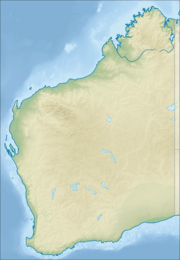Southern Beekeeper's Nature Reserve facts for kids
Quick facts for kids Southern Beekeeper's Nature ReserveWestern Australia |
|
|---|---|
|
IUCN Category Ia (Strict Nature Reserve)
|
|
| Nearest town or city | Cervantes |
| Established | 1979 |
| Area | 10,841 ha |
| Managing authorities | Department of Parks and Wildlife (Western Australia) |
| See also | List of protected areas of Western Australia |
The Southern Beekeeper's Nature Reserve is a special protected area in Western Australia. It's about 240 kilometers north of Perth, in a region called the Wheatbelt. This reserve is one of many managed by the Department of Parks and Wildlife (Western Australia) to protect nature. You can reach parts of it using Indian Ocean Drive. There are even cool spots like Molah Hill and Hill River where you can learn more.
The reserve is next to the town of Cervantes on its southeast side. To the southwest, it borders Nambung National Park. A large area of government-owned land is found along most of its eastern edge.
Contents
History of the Reserve
For many years, a special path for moving farm animals ran through what is now the Southern Beekeeper's Nature Reserve. This path was used from 1889 until 1971. It connected the towns of Dongara and Perth.
In 1979, the government officially created the Southern Beekeeper's Nature Reserve. It was set up to protect plants and for beekeeping. Even though it didn't have an official name at first, people called it Southern Beekeeper's. This was because beekeepers had been working in the area for a very long time. They would start on the coast in spring and then move their bees as the season changed.
Amazing Natural Features
The Southern Beekeeper's Nature Reserve is part of a long coastal stretch. This area includes Nambung National Park and Wanagarren Nature Reserve to the south. Together, they have 18 beaches along 42 kilometers of coastline.
Some sandy parts of the reserve have large, moving sand dunes. These dunes are shaped like parabolas, which means they are U-shaped with the open end facing the wind. They slowly move across the landscape.
Plants and Animals
The reserve is home to many different types of plants. Most of the plants are scrub heath and a special kind of heath called Kwongan heath. You can also find areas with Banksia trees and clumps of tuart trees. These trees are growing near the northern edge of where they usually grow.
Unfortunately, at least 18 types of plants that don't naturally belong here have been found. These are called invasive plants. They can sometimes cause problems for the native plants.
Many animals live in the Southern Beekeeper's Nature Reserve. Scientists have seen six different kinds of native mammals here. They have also identified 56 types of birds, three kinds of frogs, and eleven kinds of reptiles. It's a busy place for wildlife!
Challenges for the Reserve
The town of Cervantes is surrounded by protected areas. The Southern Beekeeper's Nature Reserve is to the north, and Nambung National Park is to the south. There have been ideas to change the reserve's border. This would allow the town to grow without affecting Nambung National Park too much.
Also, some areas within the reserve have been marked for possible mining activities. This means there are claims for mining rights in parts of the reserve.
Another challenge is a plant problem called Phytophthora dieback. This is a type of disease that can harm plants. It has been found along roads leading to the reserve. It is also known to be in the nearby Nambung National Park. Protecting the plants from this problem is an important task for the reserve managers.


